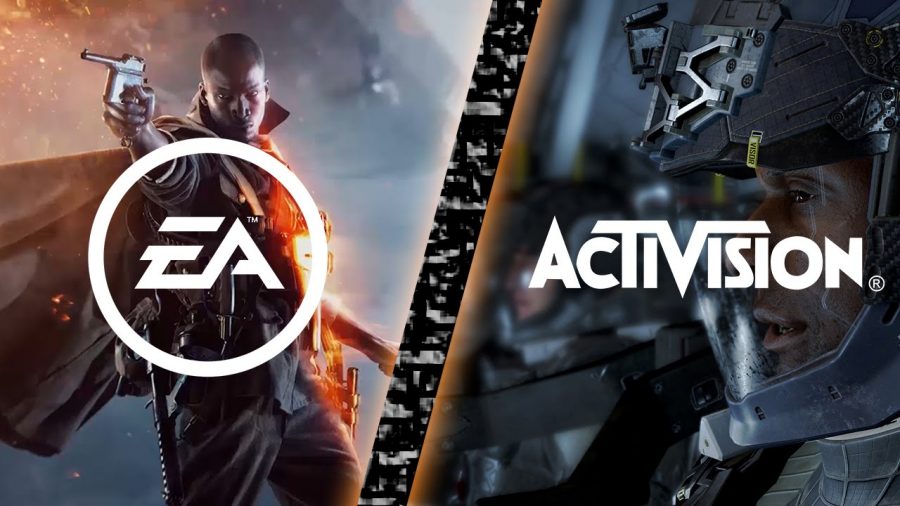They’re More Different Than You Think
A comparison of Battlefield and Call of Duty, arguably two of the most iconic and best-selling video games.
https://www.youtube.com/watch?v=877OpJNsmBc
DICE’s Battlefield 1 and Call of Duty in a side-by-side
December 16, 2019
Some of the most prolific rated “M” games in the world are also the most competitive and comparable.
DICE’s Battlefield and Activision’s Call of Duty, are the most comparable and realistic of the first-person shooters. They both use cutting edge graphics, but they are marketed towards different people.
Both companies use the most recent and most advanced graphics to portray their games. From the luscious green fields of the French countryside in Battlefield V, to the grimy close quarters of the bunkers of Fort de Vaux in Battlefield 1, Battlefield captures the close quarters’ melee and excitement of a battle revolving around you.
Unlike Battlefield, with its crumbling surroundings and interactive environment, Call of Duty appeals to the more arcade-style desired by many young people and adults alike. The game is a more fast-paced option in the ever-changing rhythm of the gaming community. It has the same feeling of when it did when it came out in the early 2000s.
Both game series came out in the early 2000s; however, they both have turned in very different ways. Battlefield goes for realism and a more realistic experience, with a magnetic and emotional story. It also uses a destructible environment, that can open up new flank routes and new cover.
Call of Duty as a series goes in a more arcade-style. This is not a bad thing, as the more recent games in the series have the most unrealistic features. Before Call of Duty returned to its roots and remade Call of Duty WWII, the main trend that they were repeating was the ultra-futuristic environment. Now, even though they have repeated the same style, they are not the only ones to do such a thing.
The Battlefield series has a tendency to repeat the modern and current battles in Bad Company, Bad Company 2, Battlefield 3, and Battlefield 4. All these games repeat the same genre: the modern and hypothetical battle scenarios.
Both games are a marvel of design and visuals. From the smallest details, like the shimmer in a person’s eyes, to the reflection and mirroring of details in windows or the water on the ground. Looks aren’t everything, it also matters if the game runs properly; this means that there are no glitches or bugs in the game.
Both game series have their problems that commonly come up. Just to name the most common ones in the Call of Duty series: timing, things that happen from your point of view may not even appear on the other person’s view. For example, if you go around a corner you may get shot and on your screen, you barely come around the corner. However, on the other person’s screen, they see your full body for a good while.
The Battlefield series is not immune to its fair share of reoccurring glitches and bugs, such as the multiple times that you will often not be able to hear anything around you, or the common occurrence that happens when people seem to defy physics. People in Battlefield games always seem to float up into the sky, or they seem to just flop about the map on the ground, not possible for a normal human being.
Not to say that this is the reason that you shouldn’t play either series, but those are just some flaws with the series. They both look and feel amazing, but Battlefield goes that extra mile and does a better job with the consistency of its gameplay. However, some people would enjoy the randomness and inconsistencies of the Call of Duty series.
The stories in both games have their moments of extreme violence and emotion, however as well as having good moments, they also have bad ones. In the Battlefield series, the developers, DICE and EA, focus more on the emotional and impactful stories. For example, in Battlefield 4 they show the dynamic squad on a U.S mini-carrier. It takes place in the South China Sea, with an escort fleet that eventually gets destroyed by the Chinese navy.
This is no unprovoked attack. The Chinese that attack the fleet believe that the Americans have assassinated a high ranking official in the Chinese government. In the end, the truth is revealed, and in an ironic twist, the supposedly assassinated individual is actually on the ship. He arrived on the ship apart of a large group of refugees that boarded the ship after an uprising in a major coastal city on the Chinese coast. After all, it is the loyalty of the navy to their representative, Jin Jei, that leads the navy to stop their final assault on the undefended carrier.
In the Call of Duty series, the campaigns look very real. In their most recent installment, Modern Warfare, the graphics look so good you could almost be mistaken that it is a movie. On the other hand of good graphics, the main story in many of the Call of Duty games are bland, and it feels like there is no emotional connection. In the Call of Duty WWII game, the story is not bad, but there is really nothing special about the campaign. There is only one mission that even comes close to being remarkable. It is a mission of a French spy who infiltrates the German command. The mission is a stealth mission, but of course all good things must come to an end, and said mission becomes a “shoot em’ up” level.
These are minor mistakes that can be fixed very easily, but in an AAA title like Battlefield or Call of Duty you’d think that the developers would be more careful and more attentive to where their game is heading. Even though these games have their issues, overall they both are remarkable game companies and make high quality and fun pieces.






